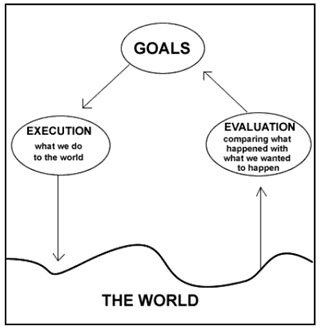

Having even the most basic understanding of how people do things can help us design better user interfaces.
Norman's theory of basic action identifies three basic stages:
Norman expanded the theory to include 7 stages
| Stage of Action | Design Question: How easiliy can the user ... ? |
|---|---|
| Form the goal | Determine the function of the product or system |
| Form the intention | Tell what actions are possible |
| Specify an action | Determine mapping from intention to action |
| Execute the action | Perform the action |
| Perceive the state of the world | Tell if the system is in the desired state |
| Interpret the state of the world | Determine the mapping from system state to interpretation |
| Evaluate the outcome | Tell what state the system is in |
Related to the theory of action is the gulf of execution and the fulf of evaluation. These explain the gaps that exist between the user and the interface and point to how to better design an interface so that the user can cope with it.

Gulf of execution: is the distance between the user's goals and the means of achieving them through the system
Gulf of evaluation: the amount of effort required to determine the system state
Question: think of a situation where you could use this theory to explain a problem you had with an interface you were trying to use ( eg think about ATM machines, photocopiers, dvd recorders etc)
![]()
Source: Adapted from Alexander, D. (2003) Usability and human Factors 2003 Monash Web Workshop Series viewed February 28, 2007, online<http://www.its.monash.edu.au/staff/web/slideshows/usability-humanfactors/>